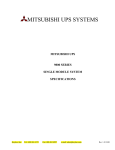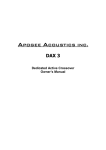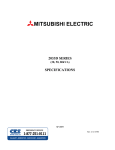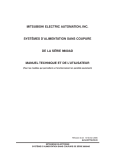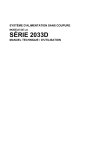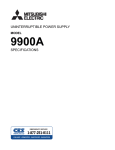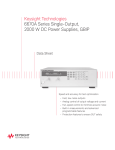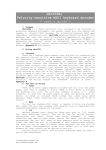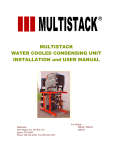Download Mitsubishi 9700 series Specifications
Transcript
MITSUBISHI UPS SYSTEMS MITSUBISHI UPS 9700 SERIES SPECIFICATIONS Rev 1 10/00 Keyitec, Inc. Tel.: 480-563 4172 Fax: 480-563 4997 e-mail: [email protected] TABLE OF CONTENTS 1.0 SCOPE ........................................................................................................ 1 1.1 The System .................................................................................................... 1 2.0 SYSTEM DESCRIPTION ................................................................................... 2.1 Components ............................................................................................. 2.2 Modes of Operation ................................................................................. 2.3 Applicable Standards ............................................................................... 3.0 PERFORMANCE CHARACTERISTICS ........................................................... 3 3.1 Power Ratings .......................................................................................... 3 3.2 Input (Converter).................................................................................... ....3 3.3 Input (Bypass) .......................................................................................... 3 3.4 Output ...................................................................................................... 4 3.5 Environment ............................................................................................. 4 3.6 Reliability ................................................................................................. 5 3.7 Maintainability ......................................................................................... 5 3.8 System Battery ......................................................................................... 5 4.0 FUNCTIONAL DESCRIPTION ......................................................................... 6 4.1 Converter......................................................................................................6 4.2 Inverter ..................................................................................................... 8 4.3 Bypass and Static Switch ....................................................................... 10 5.0 OPERATOR CONTROL PANEL ...................................................................... 11 5.1 Operator Controls .................................................................................... 11 5.2 Remote Operation ................................................................................... 11 5.3 Mimic Bus Display ................................................................................. 12 5.4 Microprocessor Interface/Diagnostics .................................................... 12 6.0 CONTROL LOGIC POWER .............................................................................. 14 7.0 UPS STATUS INTERFACING .......................................................................... 14 8.0 OPTIONAL EQUIPMENT ................................................................................. 15 8.1 Remote Status Alarm Panel (RSAP) ....................................................... 15 9.0 MECHANICAL DESIGN ............................................................................... ...15 9.1 Enclosure ................................................................................................. 15 9.2 Serviceability .......................................................................................... 15 9.3 Ventilation..................................................................................................15 9.4 Printed Circuit Boards................................................................................16 9.5 Bussbar Type..............................................................................................16 9.6 Factory Test Report....................................................................................16 9.7 Eyebolts......................................................................................................16 1 1 2 3 1.0 SCOPE 1.1 The System This specification describes an on-line, three phase, solid-state, uninterruptible power system, hereafter known as the UPS. The UPS shall operate utilizing the existing power distribution system to provide a high quality, reserve source of power to electronic equipment loads. The system shall consist of a converter, system battery, solid-state inverter, automatic static bypass transfer circuit and integral maintenance bypass circuit. 2.0 SYSTEM DESCRIPTION 2.1 Components The UPS shall be comprised of the major components listed below: 2.1.1 Insulated Gate Bipolar Transistor (IGBT) Converter Section. 2.1.2 Insulated Gate Bipolar Transistor (IGBT) Inverter Section. 2.1.3 Digital Signal Processor (DSP) using Pulse Width Modulation (PWM) for Direct Digital Control (DDC) of all UPS control and monitoring functions. 2.1.4 Static bypass switch sized to provide fault clearing. 2.1.5 Standard features: a. b. c. d. e. f. g. h. i. j. k. l. m. n. o. p. Transistorized PWM IGBT Converter. Transistorized PWM IGBT Inverter. Inverter output isolation transformer. DSP based fault memory and diagnostics. DSP based menu controlled operation. Active mitigation of reflected input harmonics (no passive filters). Active control of output voltage distortion (no passive filters). Automatic input current walk-in. Remote operation (Start/Stop of Inverter). Automatic UPS restart and load pick-up (after system battery depleted; AC restored). Programmable external customer contacts (A-Type) dry contacts. Touch screen person-machine interface. External DC Disconnect. Remote and Local Emergency Power Off (EPO). Static Bypass Disconnect. Wall mounted or free standing DC cable landing cabinet 1 2.1.6 Optional features: a. b. c. d. 2.2 Remote monitor panel. Maintenance Bypass Switch (MBS). Input AC breaker (100 ~ 225 kVA). Input Isolation Transformer (Standard option on 480V input-208/120V output units). Modes of Operation The UPS shall be designed to operate continuously at rated capacity as an on-line, automatic system in the following modes: 2.2.1 Normal - The inverter continuously supplies AC power to the critical load. The converter converts commercial AC power to regulated DC power which then serves as the inverter input and, simultaneously, as a float charge input to the storage battery. 2.2.2 Emergency - In the event of a commercial AC power failure, the inverter shall derive its input from the system battery, thus providing uninterrupted power to the critical load. This transition shall be accomplished without any switching or coupling, and with no interruption of power to the critical load from either a failure or restoration of the commercial AC power. 2.2.3 Recharge - Subsequent to restoration of commercial AC power, the converter shall automatically reactivate and provide DC power to the inverter, simultaneously recharging the system battery. This occurs automatically and without interruption to the critical load. 2.2.4 Bypass - In the event that the UPS must be taken off line due to an overload condition or UPS failure, the critical load shall be transferred to the bypass source via the static switch without interruption of power to the critical load. A paralleling, wrap-around contractor shall be used to maintain the bypass source. The static switch shall only be utilized for automatic emergency transfers. A retransfer from bypass to inverter shall be performed automatically in overload conditions. A re-transfer shall be inhibited if satisfactory synchronization of the inverter and bypass is not accomplished. The use of the static switch shall not be required during the manual or automatic re-transfer process, thus increasing reliability. 2.2.5 Remote - The UPS logic shall be capable of remote operation allowing activation of the following functions from a remote location: a. b. e. Inverter stop. Inverter start. Emergency power off. 2.2.6 Maintenance Bypass – The UPS system shall be equipped with an external MBS to allow safe and reliable maintenance of the UPS. The MBS shall be of the 2 Make-Before-Break, “Zero Energy” type to ensure maximum load reliability and personnel safety. 2.2.7 2.3 Applicable Standards The UPS has been designed in accordance with, and complies to, the following standards: a. b. c. d. UL 1778 and CSA 22.2 (cUL equivalent). IEC, Semiconductor Converter Standards. (#62040-3.2.16) ISO 9001 Quality Assurance program. This specification. 3.0 PERFORMANCE CHARACTERISTICS 3.1 Power Ratings The UPS output capacity shall be: XXX kVA/ XXX kW @ .8 pf lagging 3.2 100 kVA ~ 225 kVA Input (Converter) 3.2.1 Nominal input voltage: 208Vor 480V, 3 phase, 3 wire. 3.2.2 Input voltage range: +10%, -15%. 3.2.3 Input frequency and range: 60 Hz ± 5%. 3.2.4 Input power factor: .98 lagging minimum at 100% load; 0.95 lagging minimum at 50 % load. 3.2.5 Reflected input current THD: 3% maximum at 100% load. Typically 5% maximum at 50% load. 3.2.6 Converter walk-in time: 1 through 30 seconds (every 1 seconds selectable, 0 to 100% rated load). 3.3 Input (Bypass) 3.3.1 Nominal input voltage: 208V, 3 phase, 4 wire. 3.3.2 Input synchronization voltage range: ± 10% of nominal. 3.3.3 Input frequency tracking range: 60 Hz ± 3% maximum. The synchronous range shall be selectable 0.5% to 3% in increments of 0.1%. 3 3.4 Output 3.4.1 Nominal output voltage: 208V, 3 phase, 4 wire. 3.4.2 Nominal dynamic voltage regulation: ± 1% for unbalanced loads. 3.4.3 Manually adjustable output voltage: ± 5% range. 3.4.4 Voltage transient response: Voltage transient response shall not exceed the following, and shall recover to within nominal voltage regulation limits within 16.7 msec: a. ± 2% for a 100% load step. b. ± 1% (loss or return of AC input). c. ± 5% (inverter ⇔ bypass). 3.4.5 Output frequency (inverter synchronous): 60 Hz (tracks frequency of static bypass source). 3.4.6 Output frequency slew rate (inverter synchronized to static bypass): 0.5 Hz, 1 Hz or 2 Hz or 3Hz/second (selectable). 3.4.7 Free running output frequency (on battery or asynchronous): 60 Hz +/- 0.01%. 3.4.8 Output voltage harmonic distortion: a. b. 2% THD maximum with 100% linear load. 5 % THD maximum with 100% non-linear load. Load power factor range of 0.7 lagging to 1.0 within Kw rating of UPS. 3.4.9 Output overload capability: a. b. 105% to 125% for 10 min. (voltage regulation maintained). 126% to 150% for 10 seconds (voltage regulation maintained). 3.4.10 Output fault clearing: typically 1000% for 1 cycle (utilizing bypass source). 3.5 Environment The UPS shall be capable of withstanding any combination of the following external environment conditions without mechanical damage, electrical failure or degradation of operating characteristics. 3.5.1 Efficiency: a. b. DC to AC (emergency mode, 100% load): XX % AC to AC (normal mode, 100% load): XX % 3.5.2 Ambient operating temperature range: 0 to +40 degrees °C (no derating required). 3.5.3 Recommended operating temperature range: +20 to +30 degrees °C. 4 3.5.4 Storage temperature (non-operating): -20 to +70 degrees °C. 3.5.5 Relative humidity a. b. Maximum operating range: 5% to 95% (non-condensing). Recommended operating range: 30% to 90%. 3.5.6 Heat dissipation (at 100% load). a. b. XX kBTU/hr XX kW 3.5.7 Acoustical noise level: XX dba @ 1 meter 3.5.8 The inverter shall have an output contactor to isolate the inverter from the load and bypass source. 3.6 Reliability The UPS equipment reliability shall be represented in terms of theoretical Mean-TimeBetween-Failures (MTBF). The UPS manufacturer shall, as a minimum, provide the following capability: 3.6.1 Total single module UPS system output (includes reliability of bypass circuit): 3,000,000 MTBF hours. 3.6.2 Single module UPS operation (represents UPS module operation only): 140,000 MTBF hours. 3.7 Maintainability MTTR of the UPS shall not exceed 1 hour including time to replace components. 3.8 System Battery The system battery shall be sized to provide the specified back-up time to the inverter when the UPS is supplying 100% rated load. The battery shall be of the VRLA, Flooded Lead Acid or Nickel Cadmium types. 5 3.8.1 VRLA Battery System Example (EXAMPLE using 225 kVA UPS) a. The battery system shall include a DC landing box (Wall or floor mounted) equipped with a 600A/500Vdc breaker. The landing box shall interface the UPS’ DC input to battery cabinets. b. The battery shall be capable of operating in an average ambient temperature of 25 °C, with excursions of 16 °C to 32 °C and shall be sized as follows: 1. float voltage: 405 VDC (2.25 to 2.27 V/cell) 2. final voltage: 300 VDC (1.67V/cell) 4.0 FUNCTIONAL DESCRIPTION 4.1 Converter 4.1.1 General The Converter shall convert the incoming AC power into regulated DC power to supply the inverter input and system battery. The Converter shall utilize the following technologies: a. c. d. 4.1.2 Solid state PWM controlled IGBT power transistors switching at 6 kHZ. Switching shall be defined as IGBT turn on and turn off rate. Doubling of frequency at inverter output shall not be considered as the true switching frequency. Input Power: Rated kVA at 1:1 ratio. DSP based control logic. Input Current Limit i) The Converter logic shall provide input current limiting by limiting the AC input current. Two (2) line-side current transformers shall be employed as a means of sensing the current amplitude. The Converter logic shall also be capable of providing auxiliary current limiting when the logic is signaled to do so via an external dry contact closure (e.g.; UPS fed from motor generator). The Converter shall be capable of supplying 1 line cycle of overload current equal to 125% of its full load rating. It shall also provide sufficient capacity to provide power to a fully loaded inverter while simultaneously recharging the system battery to 90% of full capacity within 10 times the discharge time. The DC output current limit values are as follows: 6 a. b. Converter input current (maximum) 110% of nominal Converter input current (aux.) 25%-100% variable 4.1.3 Battery Charge Current Limit The Converter logic shall provide DC battery current limiting for controlled battery charging. The battery current sensing shall be independent of the Converter DC output current sensing to provide precise battery recharging. The following battery current limits shall be provided as a minimum: a. 4.1.4 Battery charge current limit 10% to 50% (adjustable) of battery Ah rate. Voltage Regulation The Converter output voltage shall not deviate by more than ± 1% RMS due to the following conditions: a. b. c. From 0 to 100% loading Converter input variations of voltage and frequency within the limitations set in section 3.2. Environmental condition variations within the limitations set in section 3.5. 4.1.5 Reflected Harmonic Content The Converter shall not produce more than a maximum of 3% reflected current distortion into the Converter input utility source when nominal voltage and rated load is applied. Typically, the amount of reflected current distortion shall not exceed 5% THD at 50 % load. 4.1.6 Automatic Input Walk-in The Converter logic shall employ circuitry to allow a delayed and timed ramping of input current. Subsequent to energizing the Converter input, the ramping of current shall be delayed by a maximum of 3 seconds. Upon starting the walk-in process, the ramping of current shall be timed to assume the load gradually within 1 through 30 seconds (every 1 second selectable). This function shall be supplied as standard equipment. 4.1.7 Input Overload Protection The 100 to 225 kVA units shall include wrong sequencing protection. 4.1.8 Equalize Charge Timer The UPS logic shall provide a 24 hour electronic automatic equalize charge timer. The timer circuit, once activated, shall provide a high rate equalizing charge voltage to the system battery for the selected time. The circuit shall also be capable of manual activation via the control-panel mounted push button and de7 activation via the control-logic mounted push button located behind the front door. The level of equalizing voltage shall be equal to that stated by the battery manufacturer (typically .04 to .08 VDC/cell higher than the specified float level). Upon completion of the timer count, the Converter output voltage shall return to the specified float voltage (typically 2.25 to 2.28 VDC/cell). 4.1.9 Input Isolation Transformer All UPS’ rated for 480V input shall include an input isolation transformer as standard equipment. An auto-transformer shall not serve as an equivalent. 4.1.10 Battery Temperature Compensation The UPS shall have, as standard equipment, a battery temperature compensation function allowing the rectifier voltage to fold-back to a safe value in the event the battery temperature reaches a pre determined dangerous level. 4.1.10 Step load (0-100%) changes 100% step load changes shall use ONLY the Converter to supply power to the inverter. The batteries SHALL NOT be cycled at any time during these step load changes. 4.1.11 DC Breaker The DC input shall be protected by a DC Breaker that shall also include circuitry to prevent wrong sequencing during startup or shutdown of the UPS system. The DC Breaker shall be provided as standard equipment. 4.1.11 DC Ripple voltage The DC buss rms ripple voltage shall be less than 1% of the UPS’ nominal DC voltage level at 100% load and with no battery connected. This shall provide for maximum battery life. 4.2 Inverter 4.2.1 General The Inverter shall generate AC power that is derived from DC power supplied from the Converter or the system battery. The Inverter shall be capable of 8 providing rated output as stated in section 3.4 while operating from any DC voltage within the battery operating range. The Inverter shall utilize the following technologies: a. b. 4.2.2 Solid state PWM controlled IGBT power transistors switching at 6 kHZ. Switching shall be defined as IGBT turn on and turn off rate. Doubling of frequency at inverter output shall not be considered as the true switching frequency. DSP based control logic. Voltage Regulation The Inverter output voltage shall not deviate by more than +/- 1% RMS due to the following steady state conditions: a. b. c. 0 to 100% loading. Inverter DC input varies from maximum to minimum. Environmental condition variations within the limitations set in section 3.5. 4.2.3 Frequency Control The Inverter output frequency shall be controlled by an oscillator internal to the UPS module logic. It shall be capable of synchronizing to an external reference (e.g.; the bypass source) or operating asynchronously. The oscillator shall maintain synchronization with the external reference within the limitations set in section 3.3.3. A message located on the touch screen shall identify the loss of synchronization. Synchronization shall be maintained at 60 Hz ± 0.01% continuously. The Inverter output frequency shall not vary during steady state or transient operation due to the following conditions: a. b. c. 0 to 100% loading. Inverter DC input varies from maximum to minimum. Environmental condition variations within the limitations set in section 3.5. 4.2.4 Output Harmonic Distortion The Inverter output shall limit the amount of harmonic content to the values stated in section 3.4.8. The use of excessive or additional filtering shall not be required to limit the harmonic content thus maintaining a high level of efficiency, reliability and original equipment footprint. 4.2.5 Output Overload Capability The Inverter output shall be capable of providing an overload current while maintaining rated output voltage to the values stated in section 3.4.9. A message indicating LED located on the control panel shall illuminate to identify this condition. If the time limit associated with the overload condition expires or the 9 overload is in excess of the set current amplitude, the load power shall be transferred to the bypass source without interruption. 4.2.6 Inverter Current Limit The Inverter output shall also be limited to 150% of rated load current. The two sensing locations shall operate separately and independently thus providing redundancy and, in the event of a failure, prevent unnecessary damage to power transistor components/fuses. Load current above 150% shall cause an immediate transfer of the load to the bypass source for fault clearing. 4.2.7 Inverter Overload Protection The Inverter AC output shall utilize electronic current limiting for overload conditions. The Inverter shall utilize a contactor to isolate its output from the critical bus. a. b. 4.3 The Inverter fuses shall be the fast acting semiconductor type to clear faults on the DC buss. The Inverter output isolation contactor shall be located internal to the UPS module and shall be controlled by the internal UPS module system logic. Bypass and Static Switch 4.3.1 General A bypass circuit shall be provided as an alternate source of power other than the inverter. A high speed SCR switch and wrap-around contactor shall be used to assume the critical load during automatic transfers to the bypass circuit. The static switch and wrap-around contactor shall derive power from an upstream bypass feed contactor internal to the UPS module. The wrap-around contactor shall be electrically connected in parallel to the static switch and shall, at the same time as the static switch, be energized and, upon closure, maintain the bypass source. The static switch shall only be utilized for the time needed to energize the wrap-around contactor thus increasing reliability. The bypass circuit shall be capable of supplying the UPS rated load current and also provide fault clearing current. The UPS system logic shall employ sensing which shall cause the static switch to energize within 150 microseconds thus providing an uninterrupted transfer to the bypass source when any of the following limitations are exceeded: a. b. c. d. e. Inverter output undervoltage or overvoltage. Overloads beyond the capability of the inverter. DC circuit undervoltage or overvoltage. Final voltage of system battery is reached (bypass source present and available). System failure (e.g.: logic fail, fuse blown, etc.). 4.3.2 Automatic Re-transfers 10 In the event that the critical load must be transferred to the bypass source due to an overload, the UPS system logic shall monitor the overload condition and, upon the overload being cleared, perform an automatic re-transfer back to the inverter output. The UPS system logic shall only allow a re-transfer to occur three times within a one minute period. Re-transfers shall be inhibited on the fourth transfer due to the likely hood of a recurring problem at the UPS load distribution. The retransfer of load to the inverter shall also be inhibited due to the limitations set in section 3.3. All retransfers will be inhibited if the inverter and static bypass line are not synchronized. 4.3.3 Manual Transfers The UPS shall be capable of transferring the critical load to/from the bypass source via the front control panel. current to the inverter. Manual transfers will be inhibited if the inverter and static bypass line are not synchronized. 4.3.4 Static Switch The static switch shall be a high speed transfer device comprised of naturally commutated SCR's. 5.0 OPERATOR CONTROL PANEL 5.1 Operator Controls The operator control panel shall employ the use of a touch screen interface which allows lock-out of all UPS control functions for security (the Emergency Power Off function shall not be locked-out). The operator interface shall provide the following: a. b. c. d. e. 5.2 UPS start-up procedure UPS shutdown procedure Emergency Power Off (EPO) Audible alarm silence System status levels Remote Operation Certain UPS controls shall, as standard equipment, be capable of being operated from a remote location. The remote functions are provided for user convenience and shall be activated via, user supplied, external dry contact switches connected at the user interface wiring terminal. The following remote control functions shall be provided as a minimum: 11 a. b. c. 5.3 Inverter stop. Inverter start. Emergency Power Off. Mimic Bus Display A mimic bus identifying the internal UPS power circuit, contactors/circuit breakers, operating status and fault conditions shall be provided on the touch screen interface. The following display shall be included: a. b. c. d. e. f. g. h. 5.4 Converter operation. Battery operation. Converter on/off. Inverter on/off. Inverter synchronized with bypass. Load on inverter. Load on bypass. Equalize charge on. Microprocessor Interface/Diagnostics 5.4.1 Microprocessor Controlled Operator Guidance The UPS’ microprocessor logic shall, as standard equipment, provide menudriven operator instructions detailing the operation of the UPS system. The instruction menu shall be accessible via a touch screen display located at the control panel. The microprocessor shall monitor each step, thus prompting itself to the next step of the instructions. The following instructions shall be available as a minimum: a. b. c. d. e. f. Inverter stop. Inverter start. UPS shutdown. UPS startup Transfer of load to static bypass. Equalize charge to system battery. 5.4.2 Microprocessor Controlled Metering All meters shall be digitally displayed having an accuracy of 1% or better. The following parameters shall be available for display: a. b. Converter input voltage (all phases) Converter input current (all phases) 12 c. b. c. d. e. f. g. h. i. j. k. l. m. n. o. p. q. Converter input frequency Battery voltage Battery charging/discharging current Battery capacity remaining during power failure conditions Battery load factor Number of times of battery operation Bypass input voltage (all phases including line-line and line-neutral) Bypass input frequency Output voltage (all phases including line-line and line-neutral) Output current in RMS Amps, % Amps and % Peak (all phases including line and neutral) Load Apparent Power (kVA) Load Effective Power (Real, kW) Load Power factor Output frequency Active Power Graph (kVA/kW) Historical Power Trend Graph (kVA/kW) Report Selectability (Three (3) times per day) 5.4.3 Microprocessor Controlled Diagnostics The UPS shall provide microprocessor controlled diagnostics capable of retaining fault alarms along with metering parameters in the event of a UPS failure. The microprocessor memory data shall be viewed via an LCD display located at the control panel. The following alarm/status information shall be provided as a minimum: a. b. c. d. e. f. g. h. i. j. k. l. m. n. r. s. t. u. v. w. x. y. z. Load on Inverter Inverter Operation Inverter Start/Stop Battery Operation Battery Low Voltage Output Overload Overload Level Set Remote Start/Stop Enabled Remote Operation Battery Depleted Battery Temperature Abnormal Converter Operation CB1 (AC input Breaker) Condition (Open or closed) CB2 (DC Breaker) Condition (Open or closed) Converter Supplying DC Power Converter Input out of Range Equalize Charge Activated Inverter Stop due to Overload Condition Inverter Running Synchronously Inverter Running Asynchronously UPS on Static Bypass Static Bypass Input out of Range UPS on Generator Power 13 aa. bb. cc. dd. 6.0 Minor fault Inverter Output Condition (Open or closed) 52C Abnormal (Inverter Output) Battery Charge/Discharge Operation CONTROL LOGIC POWER The UPS control logic power supply shall employ a redundant design utilizing the UPS utility input and the system battery as power sources. 7.0 UPS STATUS INTERFACING 7.1 User Selectable Output Contacts The internal UPS logic shall provide, as standard equipment, a programmable set of six (6) normally open, A-type dry contact outputs to allow user interfacing of the UPS operating status. The available parameters are identical to the alarm and status information schedule itemized in 5.4.3 above. 7.2 RS 232 Communication The UPS shall have, as standard equipment, an RS 232 smart port allowing the user to interface the UPS status information to a host computer. “DiamondLink” monitoring software, or equivalent, shall be available to support the specified operating system. Field installed, and field tested RS 232 additions shall not be accepted. 7.3 Input Ports The UPS shall have, as standard equipment, six (6) selectable input ports. The user can select from the following parameters: 1. 2. 3. 4. 5. 6. 7. 8. 9. 10. 11. Power Demand Battery Liquid Level Low Room Temperature Abnormal Remote Start Remote Stop Remote Equalize Charge Battery Temperature Abnormal Alarm Silence Asynchronous Command Generator Operation Retransfer 14 8.0 OPTIONAL EQUIPMENT 8.1 Remote Status Alarm Panel (RSAP) The UPS manufacturer shall offer a Remote Status Alarm Panel which shall not allow any control over the UPS. The RSAP shall have, as standard equipment, a battery backup feature allowing it to continue monitoring UPS status conditions during power outage situations. Ride through shall be for a minimum of 8 hours. The RSAP shall act only as an annunciation panel providing the following alarms/indications as a minimum: a. b. c. d. e. f. g. Converter on Load on Inverter Load on Bypass UPS Failure Output Overload UPS in battery back-up mode Low battery while in back-up mode 9.0 MECHANICAL DESIGN 9.1 Enclosure The UPS shall be equipped with standard forklift provisions to allow ease of installation using conventional lifting/moving equipment. All UPS enclosures shall require a special tool or screw driver to allow internal access. 9.2 Serviceability The UPS shall have front access only for maintenance or service. Side access or rear access shall not be accepted. The UPS shall be designed such that its rear can be pressed against a back wall and its sides can be pressed against side walls. 9.3 Ventilation 15 Forced air cooling shall be provided to allow all components to operate within their rated temperature window. Thermal relays, using a latched contact which is capable of being reset, shall be used as overload protection to all cooling fans. Each fan shall employ a separate thermal relay. All air inlets use washable air filters that shall be removable from the front of the UPS without exposure to any electrical hazard. Air filters shall be door mounted to prevent floor dust from being sucked into the unit. Bottom mount air filters shall not be accepted. 9.4 Printed Circuit Boards All printed circuit boards shall be conformally coated against corrosive vapors and to hermetically seal them. 9.5 Bussbar All bussbar used for conductivity within the UPS shall be designed with COPPER ONLY. Aluminum not acceptable 9.6 Factory Test Report All UPS units shall come equipped with one (1) factory test report included in the UPS. The factory test report shall include the following: A. B. C. D. E. F. G. H. I. J. K. Series/kVA Serial Number Date of test Approved by/Inspected by/Tested by Inspection of construction Checking of wiring (Black/Red marking on each connection point) Grounding Continuity Insulation strength test Control Circuit Operation Measurement of steady state characteristics (Voltage/current/efficiencies) Transient characteristics (0-100% step load test without batteries/voltage fluctuation) L. Overload Testing M. Transfer Switch Operation 9.7 Eyebolts Eyebolts shall be installed as standard for lifting UPS. Four (4) heavy duty eyebolts will Be installed on each corner of UPS. Eyebolts are detachable (Unscrew) once UPS is set in installation area. 16


















